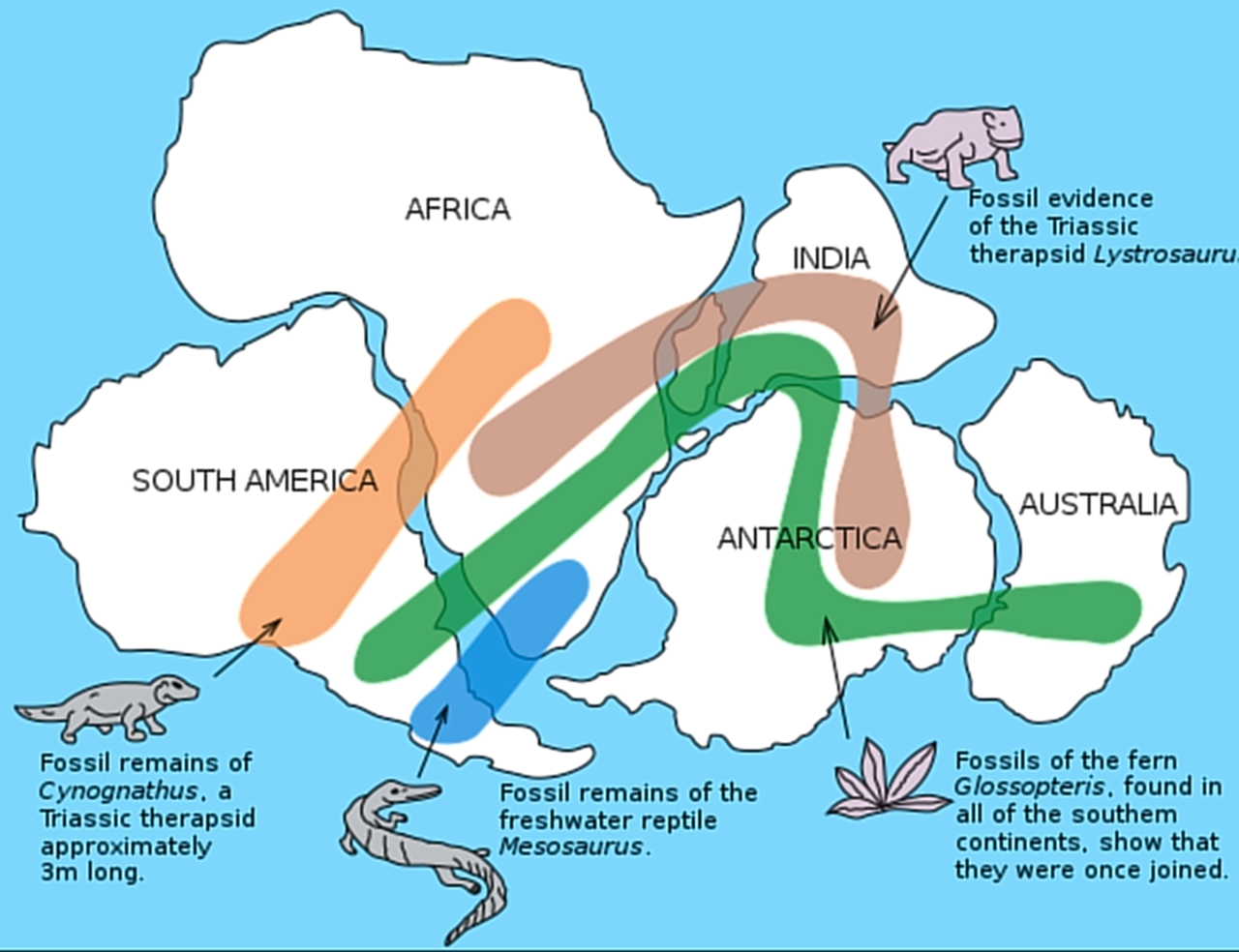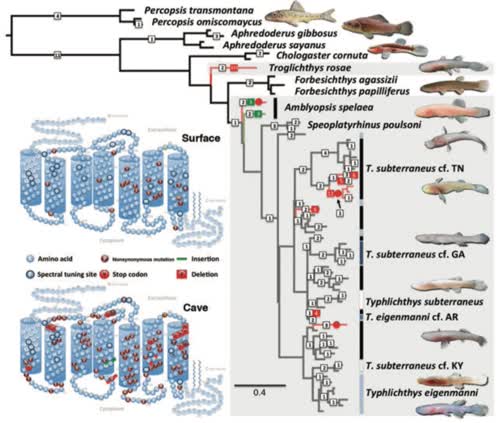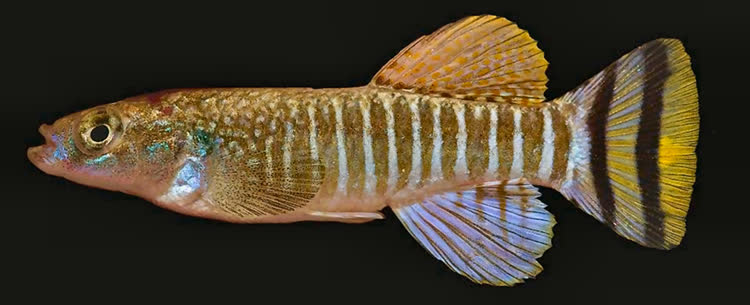|
Convergent and divergent evolution in rain-forest populations and communities of cyprinodontiform fishes (Aphyosemion and Rivulus) in Africa and South America ABSTRACT |
|
Evidence for repeated loss of selective constraint in Rhodopsin of Amblyopsid Cavefishes (Telostei: Amblyopsidae) The genetic mechanisms underlying regressive evolution—the degeneration or loss of a derived trait—are largely unknown, particularly for complex structures such as eyes in cave organisms. In several eyeless animals, the visual photoreceptor rhodopsin appears to have retained functional amino acid sequences. Hypotheses to explain apparent maintenance of function include weak selection for retention of light-sensing abilities and its pleiotropic roles in circadian rhythms and thermotaxis. In contrast, we show that there has been repeated loss of functional constraint of rhodopsin in amblyopsid cavefishes, as at least three cave lineages have independently accumulated unique loss-of-function mutations over the last 10.3 Mya. Although several cave lineages still possess functional rhodopsin, they exhibit increased rates of nonsynonymous mutations that have greater effect on the structure and function of rhodopsin compared to those in surface lineages. These results indicate that functionality of rhodopsin has been repeatedly lost in amblyopsid cavefishes. The presence of a functional copy of rhodopsin in some cave lineages is likely explained by stochastic accumulation of mutations following recent subterranean colonization. |
|
The Evolution of an Annual Life Cycle in Killifish: Adaptation to Seasonally Ephemeral Aquatic Habitat Across Two Continents "Evidence from the literature and my own comparative experiments and provide a plausible scenario for how an annual life cycle evolved through intermediate steps. Killifish are found in aquatic habitats that span a continuum from permanent and stable to seasonal and variable, thus providing a useful system in which to piece together the evolutionary history of this life cycle using natural comparative variation embedded in a phylogenetic context." |
|
The taxonomic placement of three fossil Fundulus species and the timing of divergence within the North American topminnows (Teleostei: Fundulidae) Abstract The fossils species †Fundulus detillae, †F. lariversi, and †F. nevadensis from localities in the western United States are represented by well-preserved material with date estimations. We combined morphological data for these fossil taxa with morphological and DNA-sequence data to conduct a phylogenetic analysis and a tip-based divergence-time estimation for the family Fundulidae. The resultant phylogeny is largely concordant with the prior total-evidence phylogeny. The fossil species do not form a monophyletic group, and do not represent a discrete western radiation of Fundulus as previously proposed. The genus Fundulus diverged into subgeneric clades likely in the Eocene or Oligocene (mean age 34.6 mya, 53–23 mya), and all subgeneric and most species-group clades had evolved by the middle Miocene. †Fundulus lariversi is a member of subgenus Fundulus in which all extant species are found only in eastern North America, demonstrating that fundulids had a complicated biogeographic history. We confirmed †Fundulus detillae as a member of the subgenus Plancterus. †F. nevadensis is not classified in a subgenus but likely is related to the subgenera Plancterus and Wileyichthys. |
|
Biogeography of the freshwater fishes of the Guianas using a partitioned parsimony analysis of endemicity with reappraisal of ecoregional boundaries The Guianas are one of the most diverse regions of the Neotropics, hosting a particularly high rate of freshwater fish endemism. The present distributional patterns of freshwater fish species in the major catchments of the Guianas (comprising Guyana, Suriname and French Guiana) were analysed to reveal the faunal relationships between rivers, evaluate different hypotheses concerning biogeographical units, and redefine the boundaries of the Guianese freshwater ecoregions. A parsimony analysis of endemicity was performed using a data partitioning strategy to alleviate some drawbacks inherent to the method (e.g. long branch attraction artefact, heterotachy), and take into account alternative parsimony models assigning different constraints on state changes for the different species. A strong spatial element was present in the data with a structuring of species along a west–east gradient. Two main biogeographical units were highlighted: one to the west, ranging from the Essequibo to the Commewijne rivers and including the Proto Berbice and Surinamese regions, and one to the east ranging from the Maroni to the Oyapock rivers and including the Western, Central and Eastern French Guiana regions. Each ecoregion possessed distinctive fish assemblages, and three to four potential zones of faunal exchanges between Amazonian and Guianese rivers have been confirmed. |
|
Systematics and historical biogeography of the Aphanius dispar species group (Teleostei: Aphaniidae) and description of a new species from Southern Iran Among the species of Aphanius Nardo, 1827, Aphanius dispar (Rüppell, 1828) is the most common taxon and has long been viewed as representing a species group rather than a single species. This study provides comprehensive data on the phylogenetic relationships, morphology, and otoliths within the A. dispar species group, including the description of a new species. Our data demonstrate that the “true” A. dispar is restricted to the Red Sea drainages and that all other populations hitherto identified as A. dispar actually represent separate species. Four main clades are defined and named for the geographic areas in which the respective species of Aphanius occur. The oldest one is the “Red Sea clade,” it comprises A. dispar. The “Dead Sea clade” is represented by A. richardsoni (Boulenger, 1907). It is sister to both the “Hormuzgan clade” in S Iran (containing A. hormuzensis sp. nov. and A. ginaonis (Holly, 1929)) and the “Persian Gulf & Gulf of Oman clade” (comprising A. stoliczkanus (Day, 1872)). The species separation within the A. dispar group is confirmed by the distinctive otolith morphology of each species. Moreover, we present a time‐calibrated phylogeny (chronogram) for the A. dispar species group using †A. princeps (16–17 Mya) as a minimum age and the first appearance of †Prolebias (33–34 Mya) as a maximum age for the genus Aphanius. The evolution and historical biogeography routes are discussed based on the outcome of the chronogram and in the context of the geological and climatic history of the Near East in Pliocene–Pleistocene times. |
|
Genomic Fingerprints of Palaeogeographic History: The tempo and mode of Rift tectonics across tropical Africa has shaped the diversification of the killifish genus Nothobranchius (Teleostei: Cyprinodontiformes) • New phylogeny including 79% of the eastern central African fish genus Nothobranchius. |
|
Phylogeny: Rewriting evolution they found a clear pattern: the farther away from the trunk of the evolutionary tree the animals were, the more microRNAs they had accumulated. The pair started to realize that the molecules provided “a brand new way to do phylogeny, using a set of rare genomic characters that no one had ever considered before”, Peterson says. |
|
Malagasy Boas: An evolutionary mystery The closest relative to the Malagasy boids are in South America. Both South America and Madagascar split off from A similar part of Africa albeit 100 million years apart. In Africa the boas must have died off, their niche being taken by the African rock python. So it's no great mystery - boids are also in Australia and there are probably fossils in Antarctica as well. It's a good example of a species arising in Africa that can't be found there any more.
 |


